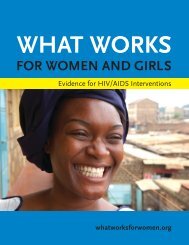Global Tuberculosis Report -- 2012.pdf
Global Tuberculosis Report -- 2012.pdf
Global Tuberculosis Report -- 2012.pdf
Create successful ePaper yourself
Turn your PDF publications into a flip-book with our unique Google optimized e-Paper software.
For consistency with VR- or survey-based mortality estimates,CFRs were estimated such that they gave the bestfit to the directly measured TB death rates (within theiruncertainty ranges) in the 125 countries with VR datathat were retained for analysis, in conjunction with WHOestimates of distributions of TB incidence in those countries.This statistical fitting used Bayesian linear modelsand was done separately for two groups of countries(high-income and all other countries), to account for differencesin the ratio of reported TB mortality to TB notificationrates among these two groups (data not shown).The models used normal errors and Gibbs sampling:y = (I – N) 1 + N 2 + , ~ N(0, 2 )where y is TB mortality from VR, I denotes TB incidenceexcluding people living with HIV, N denotes TB notificationsexcluding people living with HIV, and parametersβ1 and β2 denote the CFR in non-notified and notifiedcases respectively. Semi-conjugate priors were set with anuninformative inverse Gamma prior on the conditionalerror variance:b ~ N(b i ,B i-2), 2 ~ IG(5.10 -4 ,5.10 -4 )For low- and middle-income countries, priors b and theirprecision B were defined based on literature reviews 1and the country-year CFR parameters used by WHO forthe years 1999–2008. For high-income countries, noninformativepriors were used. Convergence of MarkovChains was assessed graphically and using convergencediagnostic tests. Within each case category 1990–2011,mortality estimates were computed by taking the productof posterior distributions of the CFR, assumed to betime-independent (Table A1.1), and country-year specificdistributions of estimated incidence.3.4 Estimating HIV-associated TB mortalityNo nationally representative measurements of HIVassociatedTB mortality were available from VR systemsfor use in this report. In the absence of direct measurements,HIV-associated TB mortality was estimated indirectlyusing a Bayesian model. It should be highlightedthat there was a significant level of sensitivity to changesin model parameters and distributions, leading to considerableand incompletely documented uncertainty surroundingestimates.A prior belief P about the proportion of AIDS deathswith TB as the contributory cause of death was definedusing evidence from a literature review 2 and the assumptionof a beta distribution with parameters a and b. Theproportion was defined as 37% (SD 3.8%). The numberof AIDS deaths was obtained from data published byUNAIDS. 3 The prior distribution’s mean of AIDS deathswith TB as a contributory cause of death was thus 37% of1.75 million AIDS deaths i.e. about 648 000 AIDS deathswith TB as a contributory cause in 2011.The likelihood for the estimated number of TB deathsamong AIDS cases was based on an assumed CFR of 50%(SD 5%) in low- and middle-income countries and a CFRof 20% (SD 2%) in high-income countries, using methodsas described above and from literature reviews. 4People with TB on antiretroviral therapy (ART) wereassumed to benefit from the protective effect of ART.To a significant extent, the protective effect depends onthe timing of ART initiation. 5 While ART increases theodds of survival when introduced early, it also shortensthe time for subclinical TB to become symptomatic, aphenomenon often referred to as “unmasking”. 6 In theabsence of reported data on the timing of ART initiationand average CD4 cell-count, we estimated the overallprotective effect of ART at 50% (SD 5%). Incident casesof HIV-positive TB were disaggregated by ART status tocalculate the likelihood for the estimated number of TBdeaths among AIDS cases, noted D.The likelihood D is a beta density with parameters s+1and f+1 obtained using the method of moments describedin Section 4.1.By combining the beta prior P with D, the posterior isalso distributed beta, with parameters a+s and b+f. Posteriordistributions were determined for each country-yeardata point.On average, when the number of TB deaths amongAIDS cases from D is less than in the prior distribution P,then the posterior distribution will be pulled away fromP towards lower values of HIV-associated TB deaths. Incountries with a high coverage of ART, D will pull theposterior distribution more strongly away from P, towardslower values.In the absence of country-specific direct measurementsof HIV-associated TB mortality reported to WHO,the Bayesian model described above was used to generateestimates of HIV-associated TB mortality. Since the priorP is based on autopsy studies in a limited number of countriesin sub-Saharan Africa (where most TB cases amongHIV-positive people occur) and based on UNAIDS estimatesof AIDS deaths (most of which occur in sub-SaharanAfrica), country-specific estimates for other countries1Straetemans M et al. Assessing tuberculosis case fatality ratio:a meta-analysis. PLoS One. 2011, 6(6):e20755.2Cox JA et al. Autopsy causes of deaths in HIV-positive individualsin Sub-Saharan Africa and correlation with clinicaldiagnosis. AIDS, 2010, 12:183–194.3www.unaids.org/en/dataanalysis/epidemiology/;accessed 15 July 2011.4Straetemans M et al. The effect of tuberculosis on mortalityin HIV positive people: a meta-analysis. PLoS One, 2010,5(12):e15241.5Piggott DA, Petros C. Karakousis PC. Timing of Antiretroviraltherapy for HIV in the setting of TB treatment. Clinical andDevelopmental Immunology, 2011 (doi:10.1155/2011/103917).6Lawn DS et al. Immune reconstitution and ‘‘unmasking’’ oftuberculosis during antiretroviral therapy. American Journal ofRespiratory and Critical Care Medicine, 2008, 177:680–685.96 GLOBAL TUBERCULOSIS REPORT 2012
















